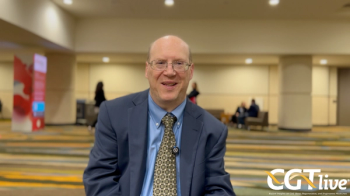
Multidisciplinary Approach to Potentially Curable Non-Small Cell Carcinoma of the Lung
In recent years, the treatment of many patients with non-small-cell lung cancer (NSCLC) has evolved into a multidisciplinary effort combining the talents of medical oncologists, radiation oncologists, and thoracic surgeons. Prospective, randomized trials have demonstrated improved survival rates in patients with locally advanced disease who are treated with cisplatin (Platinol)-based induction chemotherapy prior to radiation therapy[1,2] or surgery.[3,4] However, interpretation of these and other studies and application of the findings to the management of an individual patient require a thorough understanding of prognostic factors and staging.
In recent years, the treatment of many patients with non-small-celllung cancer (NSCLC) has evolved into a multidisciplinary effort combiningthe talents of medical oncologists, radiation oncologists, and thoracicsurgeons. Prospective, randomized trials have demonstrated improved survivalrates in patients with locally advanced disease who are treated with cisplatin(Platinol)-based induction chemotherapy prior to radiation therapy[1,2]or surgery.[3,4] However, interpretation of these and other studies andapplication of the findings to the management of an individual patientrequire a thorough understanding of prognostic factors and staging.
Weight loss, performance status, age, gender, serum lactate dehydrogenaselevel, and disease stage are all known prognostic factors for patientswith NSCLC.[5] Pulmonary function and the presence of significant heart,lung, or other medical disease must be carefully considered prior to initiatingmultimodality therapy. In general, multimodality trials have enrolled patientswith good prognostic features who were eligible to receive high-dose cisplatinchemotherapy and undergo thoracic surgery.
The importance of rigorous staging cannot be overemphasized. Particularattention must be paid to the supraclavicular (N3) and cervical (M1) lymphnode regions on examination. In addition to routine serum and hematologictesting, an assessment of cardiopulmonary function, including pulmonaryfunction tests with spirometry and measurements of diffusing capacity andarterial blood gases, is required. All patients should undergo a CT scanof the chest and upper abdomen, including the adrenal glands.
The routine use of brain and bone scans in patients with clinical stageI or II disease is controversial, but these imaging studies should be performedif clinically indicated. Patients who appear to have stage III diseaseshould routinely undergo brain and bone imaging, as there is a greaterlikelihood of metastatic spread in this group. In patients who appear tohave locoregional disease spread on CT scan, further evaluation of themediastinum via bronchoscopy and mediastinoscopy, mediastinotomy, fine-needleaspiration, or video-assisted thora- coscopy provides essential informationfor proper staging and treatment selection.
Stages I and II NSCLC
In a series of 598 resected stage I NSCLC patients from Memorial Sloan-KetteringCancer Center, the 5-year survival rate was 82% in patients with
T1 N0 disease, as compared with 68% in patients with T2 tumors.[6] Despitecomplete resection, 50% of the 62 patients who underwent wedge resectionor segmentectomy had a recurrence.
This finding is similar to the results of the Lung Cancer Study Group(LCSG) trial, which randomized T1 N0 patients to lobectomy or limited resection(segmentectomy or wedge resection). This trial found a significant increasein local recurrence and a decreased survival rate following limited resection.[7]Given these findings, it seems unwise to pursue thoracoscopic resectionfor patients with T1 N0 disease.
The rate of second primary cancers after resection of stage I NSCLCis very high; fully one-third of patients from the Memorial Sloan-Ketteringseries developed second primaries.[6] Given these findings, resected stageI patients should be encouraged to participate in chemoprevention trials.
Patients with stage II (T1-2 N1) disease represent about 10% of allpatients with NSCLC and have a 5-year survival rate of 39% following surgery.[8]Because of the poor prognosis of patients with relatively early-stage disease,research has focused on adjuvant therapies.
Trials of postoperative adjuvant therapy for early NSCLC have yieldedmixed results, although the majority of trials have been negative. A recentJapanese trial found that NSCLC patients (the majority of whom were stageI) randomized to receive oral tegafur (Ftorafur) plus uracil for 1 yearafter surgery had improved survival compared to those who received no furthertreatment.[9] Currently, the National Cancer Institute of Canada is conductinga trial comparing four courses of vinorelbine (Navelbine) and cisplatinto no additional treatment in patients with completely resected T2 N0 orT1-2 N1 NSCLC. In this study, tissue is also being collected to developa large tumor bank. This should facilitate identification of importantbiologic prognostic factors that may allow for selection of appropriatecandidates for adjuvant therapy in the future.
Induction chemotherapy with paclitaxel (Taxol) and carboplatin (Paraplatin)is currently under investigation in the Bimodality Lung Oncology Team (BLOT)trial. This trial is ongoing at seven major cancer centers across the UnitedStates.* The protocol calls for perioperative chemotherapy (two inductionand three postoperative cycles) for clinical T2 N0, T1-2 N1, or T3 N0-1NSCLC. Eligible patients must have a negative mediastinoscopy. This isthe first trial to employ induction chemotherapy for "early"-stagedisease.
Given the potential morbidity of chemotherapy and the preponderanceof negative data from the randomized adjuvant chemotherapy trials completedto date, "standard" treatment of stage I and II NSCLC remainssurgery alone. Results of trials employing newer-generation chemotherapyregimens in the preoperative and postoperative setting are anxiously awaited.
Stage III NSCLC
As discussed by Greco and Hainsworth, patients with stage IIIA NSCLCare a very heterogeneous group. At the more favorable end of the spectrumare patients with T3 N0-1 disease. Following surgical resection, thesepatients have 5-year survival rates of 40% to 50% (N0) or 20% (N1). Manysuch patients were included in the randomized perioperative chemotherapytrials of Roth et al and Rosell et al.[3,4] Both of these trials foundsignificantly improved survival rates among patients who received chemotherapyand surgery compared with those who received surgery alone.
The outcome for patients with "minimal N2" disease (intranodalinvolvement of a single ipsilateral mediastinal lymph node) found at thoracotomydepends on T-stage; patients who have T1 or T2 primary tumors fare betterthan those who have T3. Minimal N2 disease is relatively uncommon (10%to 20% of IIIa NSCLC) and is usually discovered at the time of thoracotomy.Patients with this presentation usually undergo resection that includesa complete mediastinal lymph node dissection and have a 5-year survivalrate of 30%.[10]
The optimal treatment of patients with multiple levels of N2 (nonbulky)nodal involvement is in evolution. It is clear that single-modality treatmentwith surgery or radiation alone affords little chance for long-term survival.Many phase II trials have demonstrated improved response, resection, andsurvival rates with induction chemotherapy or chemoradiotherapy beforesurgery. Other investigators have treated similar patients with chemotherapyand radiation given either concomitantly or sequentially (without surgery).The results of these trials have been strikingly similar, with most reportinglong-term survival rates in the range of 20%.
At present, it is not known whether surgery or irradiation is the optimal"adjuvant" to chemotherapy or whether "trimodality"therapy is better than "bimodality" therapy. Moreover, the valueof additional chemotherapy cycles after surgery or irradiation has notbeen established. It is noteworthy that patients who achieve a pathologiccomplete response following induction chemotherapy enjoy the best chancefor long-term survival.[11] Given that the majority of patients die ofsystemic disease, only improvements in systemic therapy will likely leadto meaningful increases in long-term survival.
Patients with multiple bulky ipsilateral nodes or extracapsular spread(the least favorable IIIA presentation) or those with contralateral mediastinalor hilar nodal disease, supraclavicular nodal involvement, or direct mediastinalinvasion (IIIB disease) should be offered combined-modality therapy withchemotherapy and irradiation. Trials currently underway are exploring refinementsin radiotherapy (dose delivery and fractionation), chemotherapy/radiationinteractions (sequential vs concomitant) and newer chemotherapy combinations.To date, there is no evidence from randomized trials that radiation givenconcomitantly with chemotherapy yields improved survival in patients withNSCLC. However, there is an increase in treatment-related toxicity withthis approach. Thus, unless future data prove otherwise, the concomitantuse of chemotherapy and radiation therapy for stage III NSCLC is not recommendedoutside the context of a clinical trial.
Postoperative mediastinal irradiation has been shown to significantlyreduce the risk of mediastinal relapse but does not have a measurable effecton survival in patients with resected, node-positive NSCLC. Studies ofpostoperative chemotherapy for stage III disease have shown no benefiton overall survival. The LCSG trials employing cyclophosphamide (Cytoxan,Neosar), doxorubicin, and cisplatin chemotherapy after surgery did notshow a significant improvement in overall survival.[12,13] Similarly, trialsconducted at Memorial Sloan-Kettering Cancer Center[14] and in Japan[15]found no benefit of postoperative high-dose cisplatin and vindesine (Eldisine)chemotherapy.
Finally, patients with malignant pleural effusions (T4) should not beconsidered for combined-modality therapy, as their prognosis mirrors thatof patients with metastatic disease.
Conclusions
As reviewed by Greco and Hainsworth, a number of new chemotherapeuticagents that hold promise for the treatment of patients with stage IIIBand IV NSCLC have been identified recently. New chemotherapy combinationsof paclitaxel/cisplatin, paclitaxel/carboplatin, and vinorelbine/cisplatinappear to be superior to etoposide (Etopophos/VePesid)/cisplatin. Othercombinations incorporating gemcitabine (Gemzar) and topotecan (Hycamtin)are now being tested. Incorporation of the "new generation" ofchemotherapy into the therapy for NSCLC will hopefully lead to improvedsurvival for all patients with this disease.
References:
1. Dillman RO, Herndon J, Seagren SL, et al: Improved survival in stageIII NSCLC: Seven year follow-up of CALGB 8433 trial. J Natl Cancer Inst88:1210-1215, 1996.
2. Sause WT, Scott C, Taylor S, et al: RTOG 88-08 and Eastern CooperativeOncology Group (ECOG) 4588: Preliminary results of a phase III trial inregionally advanced, unresectable NSCLC. J Natl Cancer Inst 87:198-205,1996
3. Roth JA, Fossella F, Komaki R, et al: A randomized trial comparingperioperative chemotherapy and surgery with surgery alone in resectablestage IIIA NSCLC. J Natl Cancer Inst 86:673-680, 1994.
4. Rosell R, Gomez-Codina J, Camps C, et al: A randomized trial comparingpreoperative chemotherapy plus surgery with surgery alone in patients withNSCLC. N Engl J Med 330:153-158, 1994.
5. O'Connell J, Kris M, Gralla R, et al: Frequency and prognostic importanceof pretreatment clinical characteristics in patients with advanced NSCLCtreated with combination chemotherapy. J Clin Oncol 4:1604-1614, 1986.
6. Martini N, Bains MS, Burt ME, et al: Incidence of local recurrenceand second primary tumors in resected stage I lung cancer. J Thorac CardiovascSurg 109:120-129, 1995.
7. Ginsberg RJ: The role of limited resection in the treatment of earlystage lung cancer. Lung Cancer 11(suppl 2):35-36, 1994
8. Martini N, Burt ME, Bains MS, et al: Survival after resection ofstage II non-small-cell lung cancer. Ann Thorac Surg 54:460-466, 1992
9. Wada H, Hitomi S, Teramatsu T, et al: Adjuvant chemotherapy aftercomplete resection in NSCLC. J Clin Oncol 14:1048-1054, 1996.
10. Martini N, Flehinger BJ, Zaman MB, et al: Results of resection innon-oat cell carcinoma of the lung with mediastinal lymph node metastases.Ann Surg 198:386-397, 1983.
11. Pisters KMW, Kris MG, Gralla RJ, et al: Pathologic complete responsein advanced non-small-cell lung cancer following preoperative chemotherapy:Implications for the design of future non-small-cell lung cancer combinedmodality trials. J Clin Oncol 11:1757-1762, 1993.
12. Holmes EC, Gail M, and The Lung Cancer Study Group: Surgical adjuvanttherapy for stage II and stage III adenocarcinoma and large cell undifferentiatedcarcinoma. J Clin Oncol 4:710-715, 1986.
13. Lad T, Rubinstein L, Sadeghi A, et al: The benefit of adjuvant treatmentfor resected locally advanced NSCLC. J Clin Oncol 6:9-17, 1988.
14. Pisters KMW, Kris MG, Gralla RJ, et al: Randomized trial comparingpostoperative chemotherapy with vindesine and cisplatin plus thoracic irradiationwith irradiation alone in stage III (N2) NSCLC. J Surg Oncol 56:236-241,1994.
15. Ohta M, Miyazawa N, Watanabe Y, et al: Adjuvant chemotherapy forcompletely resected stage III NSCLC: Results of a randomized prospectivestudy. J Thorac Cardiovasc Surg 106:703-708, 1993.
Newsletter
Stay at the forefront of cutting-edge science with CGT—your direct line to expert insights, breakthrough data, and real-time coverage of the latest advancements in cell and gene therapy.

















































